Excerpts from Jim Conrad's
Naturalist Newsletter
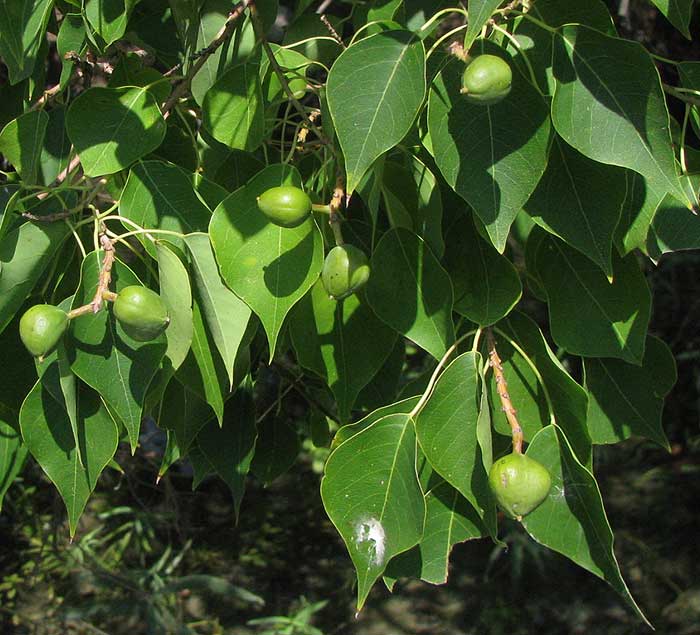
from the the September 23, 2012 Newsletter issued from the valley of the Dry Frio River in northern Uvalde County, southwestern Texas, on the southern border of the Edwards Plateau; elevation ~1750m (~5750 ft); N29.62°, W99.86°; USA
CHINESE TALLOW TREES
At the water's edge along the Dry Frio River just below the cabin there's a robust tree with dark green leaves looking a little like a cottonwood's, except that the blade margins are smooth instead of serrated. The blades are smallish, only about three inches long
(8cm). Above you can see some on their long petioles, along with some immature fruits.
Nowadays some of the capsular, three-lobed fruits are just beginning to split open, each capsule releasing three spherical, white seeds. The seeds are white because they are coated with a white, waxy substance. You can see a split-open fruit with one white seed remaining attached with its funiculus below:
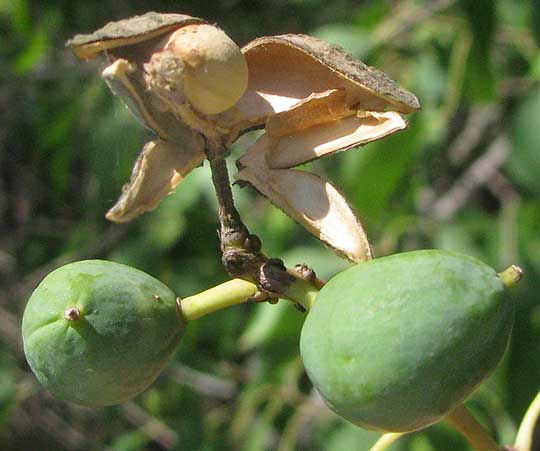
The tree's gray bark is shown below:
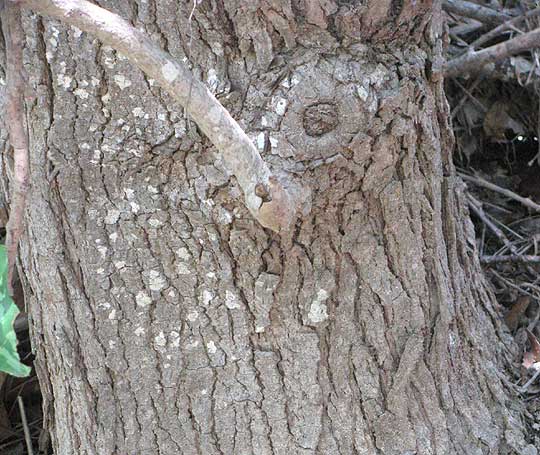
This is the Chinese Tallow Tree, TRIADICA SEBIFERA, in the US regarded as a terrible invasive infamous for pushing aside native species, and I'm sorry to see it so well established here. Along the Dry Frio it appears to be replacing American Sycamores, though elsewhere in Texas it's been observed turning Gulf Coast grasslands into single-species forests of Chinese Tallow Trees. It even changes soil conditions with the high levels of tannins in its leaf litter. Unlike most invasives, it can insinuate itself into quality, undisturbed natural forests, displacing native species.
Chinese Tallow Trees are native to China and were introduced into South Carolina in 1776 as an ornamental tree and for seed oil production. The seed's white waxy aril can be used in soap making but the seed's oil is toxic and has proved to offer only limited industrial uses. The ecological damage the tree causes is profoundly greater than any economic value it may have.
The species belongs to the Euphorbia or Poinsettia Family, the Euphorbiaceae.
Chinese Tallow Trees are sensitive to cold so until now they have escaped only in the US southern tier of states, including California plus Oklahoma.
from the December 16, 2012 Newsletter issued from the valley of the Dry Frio River in northern Uvalde County, southwestern Texas, on the southern border of the Edwards Plateau; elevation ~1750m (~5750 ft); N29.62°, W99.86°; USA
CHINESE TALLOW TREES FRUITING
Now the Chinese Tallow trees that grow thickly along the banks of the little Dry Frio River behind the cabin are mostly leafless but many are heavy with clusters of white seeds, inspiring one of the tree's names, Popcorn Tree. Below you can see a fruiting branch, and a male Cardinal answering the question of whether birds feed on the fruits:

A close-up of some seed clusters is shown below:

You know that those are seeds and not fruits if you've seen the three-lobed capsular fruits that preceded them, and which appear atop our Tallow Tree page. The thin fruit walls fall from the tree leaving the white seeds. A coating of white, waxy substance on the seeds gives the seeds their color. The wax is fairly thick, as shown below:

On the Internet many pages speak of the traditional use of Tallow Tree wax for making candles, coating paper for water resistance, etc. Our trees' seeds seemed to be covered with ample wax so I decided to melt some wax off and see what it looked like. First I tried placing a handful of seeds into a saucer, which I placed inside a closed skillet with a fire beneath it, thinking the heat would cause the white wax to melt into the saucer. The seeds got hot enough that some of them popped like popcorn, but no wax pooled in the saucer. Then I put the seeds into boiling water. A mere film of soapiness eventually spread across the water's surface, but the white "wax" on the seeds stayed in place.
In an online paper at the Purdue University website I read that "Tallow is separated by placing the seed in hot water, thereby melting the tallow which floats on the surface, or by melting tallow with steam and collecting it when it drops off. Solvent extraction of the tallow from the seed is also used, tallow still adhering to the seed being removed by an alkali treatment."
I must be doing something wrong. But that's my experience with it.
issued on June 15, 2021 from the valley of the Dry Frio River in northern Uvalde County, Texas, USA
CHINESE TALLOW TREES
This week the Chinese Tallow trees are flowering along the Dry Frio. Below is an inflorescence, with maturing female flowers below and, above, a spike-like collection of many cymules:
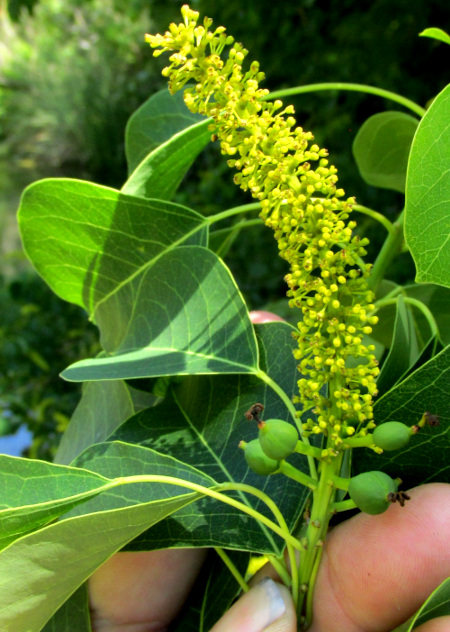
The maturing female flowers with their blackish stigmas are shown below:
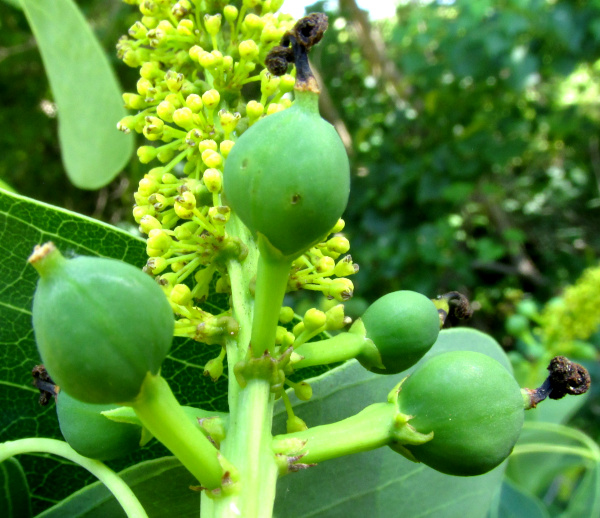
Here's a close-up of the male part of the inflorescence:

Beneath a dissection scope, an almost mature male flower displays its two anthers, each composed of two locules filled with pollen, below:

from the November 10, 2002 Newsletter issued from a few miles south of Natchez, Mississippi, USA
CHINESE TALLOW TREES
When people in town leave large plastic bags of lawn leaves along curbs for pick-up by the city, sometimes the plantation manager takes a trailer into town, drives around and collects all the bags she can, then I dump them on the gardens as mulch. When I can get all the leaves I want I cover the winter garden nearly knee deep with leaves. In spring, wherever I dig up the soil for planting, I work the leaves into the soil. By August nearly all signs of leaves have disappeared -- have turned into organic matter, thus enriching the soil and improving its texture.
Another benefit of this practice is that often along with the leaves people inadvertently send us bulbs, tubers and rooting stems of horticultural species they've discarded. When spring comes, you just never know what will be sprouting from our imported leaf-mulch.
Two springs ago a number of sprouts came up that at first looked like some kind of ornamental poplar. The sprouts quickly grew into pretty trees with dense, triangular, yellow-green leaves on long petioles, which quaked nicely in the breeze. In these two years they've grown to about 15 feet tall (4.5 m), so I'd been thinking we had a fine tree for planting somewhere.
But then Friday I was walking in the woods and discovered a cluster of trees of the same species. They'd clearly grown there for many years, taking over a small part of the woods. Spotting some branches bearing fruits, I knew instantly that the trees weren't poplars. The fruits were black capsules about the size of marbles, divided into three chambers, and each chamber held one large seed. The seed was black but covered with a thick, white, waxy substance. I could scrape the wax off with my fingernail exactly as if it were the wax covering store-bought cheddar cheese.
With the fruit I knew instantly that this was a member of the Euphorbia Family, the family in which you find Poinsettias and Castor-beans (Mole Plants). Knowing the family, back in the trailer with my books it was easy to figure out what it was. It was the Chinese Tallow-tree, also called Vegetable Tallow, SAPIUM SEBIFERUM. This was a new tree for me, and thus a real red-letter day. I could hardly wait to Google it.
The first Web page Google came up with told about the plant's many uses. Originally from China, the tree was introduced into the US because it was valued for its seeds as a source of vegetable tallow, a drying oil and protein food, and as an ornamental. The Chinese traditionally had a multitude of uses for the seeds and wood, including the practice of placing a certain insect on the tree to feed. The insect would lay its eggs in the seed and the resulting larvae would twitch inside the seed so violently that "jumping beans" would result.
The next Web page Google came up with was from the University of Florida and it said that the species "grows and spreads rapidly, is difficult to kill, and tends to take over large areas by out-competing native plants. Chinese tallow is spreading rampantly in large natural areas." The main focus of this page dealt with how to kill this "invasive non-indigenous species."
So, there you have it. A species that's highly honored in one part of the world becomes a villain in another, and can even confuse a poor hermit-naturalist. With global warming, maybe it will eventually become rampant here, as it already has in some spots in Florida. I think that instead of planting my sprouts I'll dig them up and chop them to pieces.